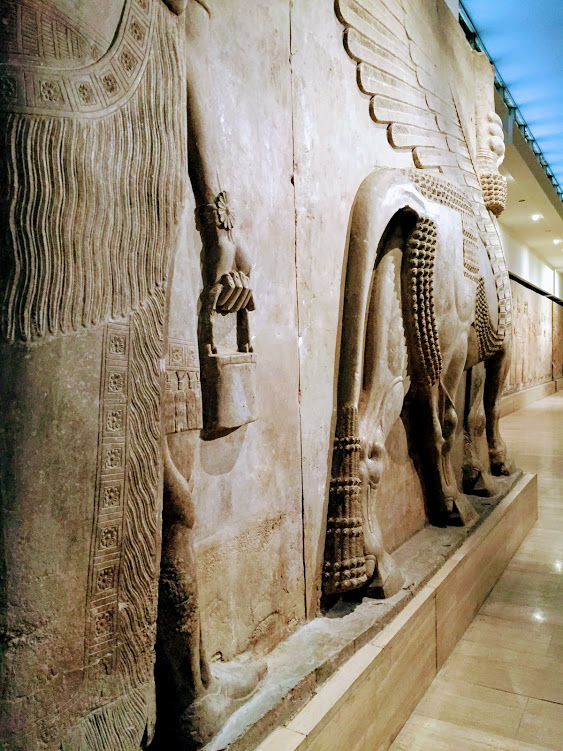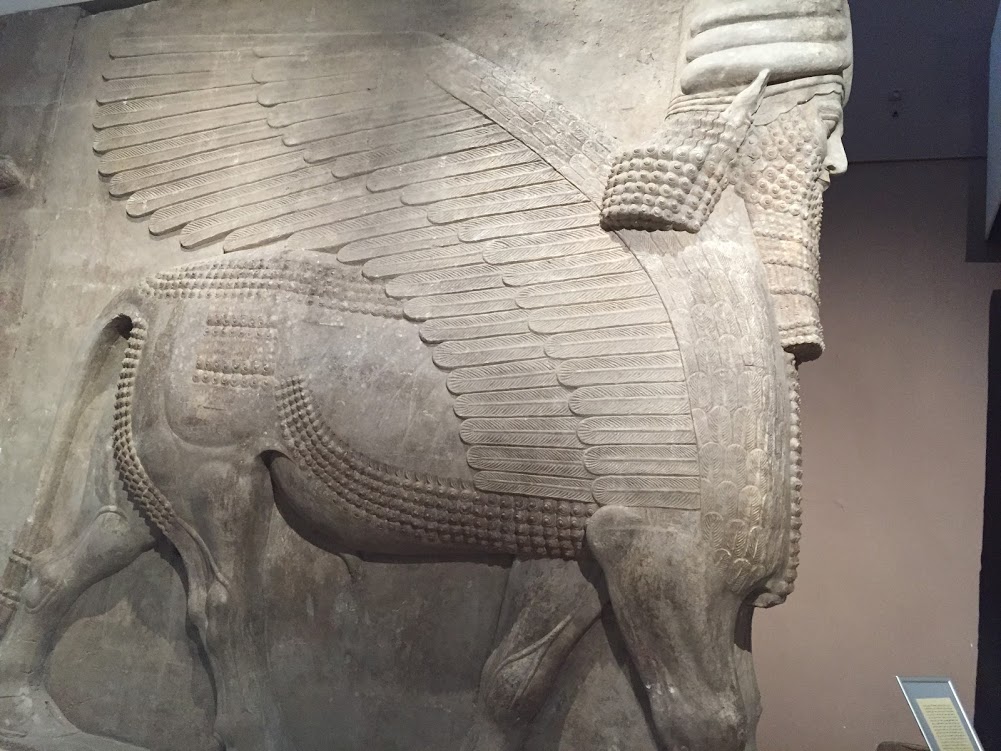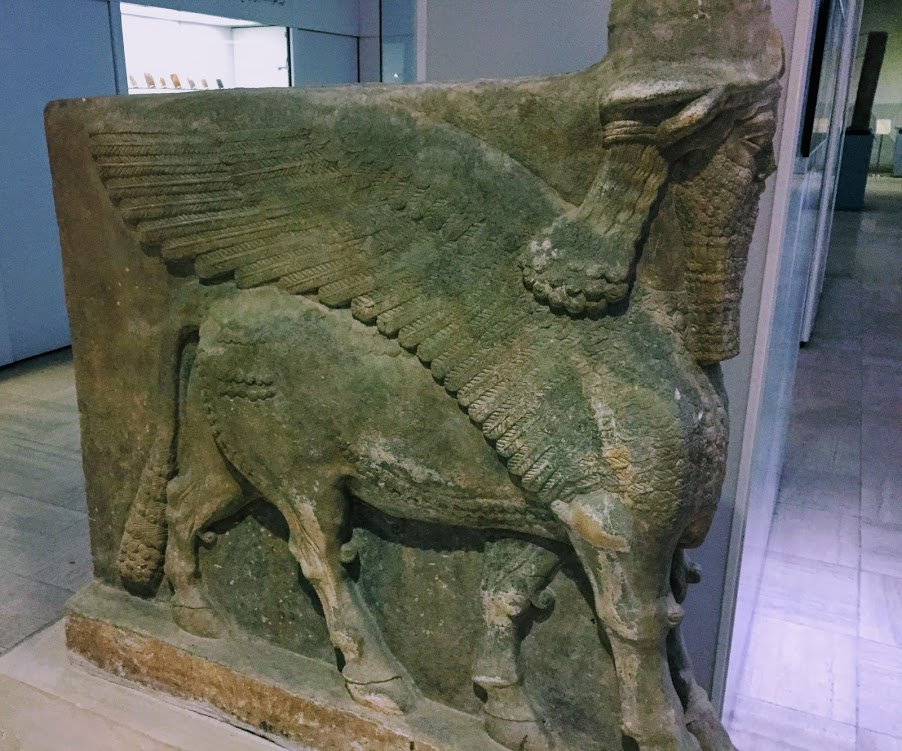I am sharing with you my experience of visiting the Iraq museum in Baghdad yesterday, where I saw one of the most amazing ancient sculptures ever: the Lamassu. The Lamassu is a mythical creature that has the body of a bull, the wings of an eagle, and the head of a human. It was used as a protective symbol by the Assyrians, who placed them at the entrances of their palaces and temples. The Lamassu is also known as a Shedu, which means “protector” in Akkadian.
Lamassu were supernatural spirits, sometimes called demons or genies depending on which language you’re translating from, who served to protect the gods, as well as the important human structures. From the ninth to the seventh century BCE, the kings of Assyria ruled over a vast empire centered in northern Iraq. Under the reign of two great Assyrian kings known as Ashurnasirpal II (883-859 BCE) and Sargon II (722-705 BCE), they both established prominent capitals a century apart with a common inclusion of a hybrid mythological guardian creature known as the Lamassu. Lamassu in the Akkadian language means “protective spirits.”
The Iraq museum has several Lamassu statues on display, but the most impressive one is the one from the palace of Sargon II in Khorsabad. It is over 4 meters tall and weighs more than 30 tons. It was carved from a single piece of limestone around the 8th century BCE. The details on the sculpture are incredible: you can see the curls of the beard, the feathers of the wings, and the muscles of the body.

Lamassu is clearly an intriguing creature, but where does it come from? The Lamassu is a celestial being from ancient Mesopotamian religion bearing the head of a man, the wings of an eagle, and the hulking body of a bull, sometimes with the horns and the ears of a bull.
Lamassu frequently appear in Mesopotamian art and mythology. The first recorded Lamassu comes from ca. 3000 BCE. Other names for Lamassu are Lumasi, Alad, and Shedu. The earliest examples of something bearing this resemblance dates back to the Sumerian civilisation of Mesopotamia. The Sumerians recognised a protective deity named Lama, or Lamassu, with a female human form who was a servant of the gods. This protective spirit became very popular in the Assyrian culture of ancient Mesopotamia, and later spread to the Persian Achaemenid Empire (550–330 BCE) as well.

The most famous colossal statues of Lamassu have been excavated at the sites of the Assyrian capitals established by King Assurnasirpal II (reigned 883 – 859 BCE) and King Sargon II (reigned 721 – 705 BCE). The Assyrians envisioned a protective spirit that was part bull and part human (and sometimes part eagle). Instead of being female, this spirit was male, with a nice, long Assyrian beard. It’s worth noting that there was female lamassu as well, which are called “apsasu”.
Ashurnasirpal II, the first great Assyrian king, constructed a new capital in Kalhu (present-day Nimrud) to represent his power and reign over his vast empire. At the entrances to this palace complex, there were hybrid supernatural figures with a bearded human head, the body of a bull or a lion, wings of a bird, and 5 legs that stood guard at all entrances to the palace; this creature is known as the Lamassu, as a protective spirit and a symbol of the power of the Assyrian king. Behind them were colossal winged human figures of the same height, bearing the pine cone and basket – winged genies.
Winged genies are usually bearded male figures sporting birds’ wings. The winged genies are a reappearing trait in ancient Assyrian art and are displayed most prominently in palaces or places of royalty. The two most notable places where the genies existed were Ashurnasirpal II’s palace Kalhu and Sargon II’s palace Dur-Sharrukin (current Khorsabad, Iraq).

Every important city wanted to have Lamassu protect the gateway to their citadel. At the same time, another winged creature was made to keep watch at the throne room entrance. Additionally, they were the guardians who inspired armies to protect their cities. The Mesopotamians believed that Lamassu frightened away the forces of chaos and brought peace to their homes.

The Lamassu figures are a very interesting example of Neo-Assyrian Art. For several hundred years (934-609 BCE) Assyria was the most important and influential empire in the Mesopotamian region. The kings at this time used art as a way to make certain everyone knew of their importance.
Relief sculpture is by far the most striking manifestation of Achaemenian art. Adopted as the basis of the new style was the straightforward technique of the Assyrians, with its engraved detail and lack of modelling.

The representation of the human-headed winged bull is the cross of two perspectives, changing from high relief in the flat area (side view) to the full-relief view of the forward portion of the sculpture. The materialisation of the figure emerging from the raw stone block stress the link between creature and palace, as well as dynamic power and motion to the visitors, and thus intended to guard and protect against evil powers. The precarious balance between the motionless posture of the forward-looking portion and the dynamic movement of the side view originates a sedate unsteadiness bringing the creature to life.


The sculptures were meant to be seen in one of two ways – from the front looking directly at the face, or from the side as the viewer entered the king’s throne room. Therefore the figures are sculpted with five legs – two legs that can be seen from the front view and four legs that can be seen from the side. This would indicate that the figure was a four-legged beast, but the extra leg was added so that the side view made visual sense. The figures were carved in relief, that is they were not free-standing sculptures but rather only part of the figure was carved and they needed a wall to support them.


Every important city wanted to have Lamassu protect the gateway to their citadel. At the same time, another winged creature was made to keep watch at the throne room entrance. Additionally, they were the guardians who inspired armies to protect their cities. The Mesopotamians believed that Lamassu frightened away the forces of chaos and brought peace to their homes. The most famous colossal statues of Lamassu have been excavated at the sites of the Assyrian capitals established by King Assurnasirpal II (r. 883 – 859 BCE) and King Sargon II (r. 721 – 705 BCE).


The Akkadians associated the human-bull hybrid as a gatekeeper associated with the god Papsukkal, who is the attendant deity of Anu (sky god of the supreme deities) and functions as a gatekeeper in the spiritual world by providing a pathway between the higher gods and humans. While these hybrid creatures were supernatural beings, they were superior to humans but were not considered to be deities. Even though the Lamassu does wear a horned cap/tiara, which proves their divinity, they were not considered deities in their culture.
After the Assyrians, the Achaemenid Empire of Persia also widely embraced this figure and its protective function. The Lamassu – a symbol combining man, bull, and bird – combines the strength of a bull, the freedom of an eagle, and the intelligence of a human being.
I was awestruck by the sight of this majestic creature. It made me feel like I was transported back to ancient times, when Mesopotamia was the cradle of civilization. I learned so much about the history and culture of this region from the museum guides and the informative panels. The Iraq museum is definitely a must-see for anyone who loves archaeology and art.




Amazing artifacts! I hope they last the test of time. Thanks for sharing!
LikeLiked by 1 person
Thanks, Riley.
LikeLike
You’re welcome!
LikeLiked by 2 people
I have seen these figures in the encyclopedia and also when I read about this region. So, this was much before Islam swept across the region? It looks like in many ways this civilization was much more advanced and evolved than the current religion which is quite rudimentary
LikeLiked by 1 person
That was the time when all great civilisations like, Roman, Greek, Egyptian, Mesopotamian, Persian and Indian, reached their heights, but the mankind couldn’t maintain the development. You can note the details in the reliefs, which show their skills and cultural diffusion. We are still wondering how the people at that time would have constructed the majestic ziggurats, pyramids. How the astronomers studied and marked the movement of celestial bodies with such precision without any telescope, etc.
LikeLike
Indrajit, I have all reasons to believe that all these civilizations were highly developed and had attained some sort of sophistication Which is completely missing in the current times…. In the entire middle East. To me it looks like the current civilization is without any sophistication.
LikeLiked by 1 person
I agree with you, Arvind. History has shown that it’s a cyclical process and let’s hope that the humanity will reach its zenith again.
LikeLiked by 1 person
I hope so. It’s actually strange to know that people don’t even talk about Mesopotamia and Persia, Which was once a great civilization. Egypt is the only country which has been able to encash some bits along with Greece and Italy. Religion and politics seems to be the culprit in this scheme.
LikeLiked by 2 people
Yes Arvind, I agree with you.
LikeLiked by 2 people
🙂
LikeLiked by 2 people
It is great to see that these artifacts were safe from the barbarian invaders in the middle ages and are intact as opposed to the ones that we see in India, vandalized by the invaders.
LikeLiked by 1 person
Aro, the situation is rather very bad in Iraq, unfortunately. Many of the thousands of years-old artefacts and remnants of ancient civilisations have been vandalised by invaders, looted by greedy people, lost due to ignorance or apathy and these happened till recently. After the US invasion in 2003, even the museums were looted and artefacts were sold and smuggled out. The last blow came from ISIS when they devastated and demolished the artefacts, remains of the buildings etc and we all watched those videos helplessly. Lamassu, of course, is impossible to loot because of its size and weight. Many artefacts are now safe in museums in the US, London, Paris and Baghdad. Read my next post on the National Museum of Iraq.
LikeLike
Thanks for this informative post and an engaging conversation! Loved it. 🙂
LikeLiked by 2 people
Thanks, Balroop.
LikeLiked by 1 person
Pingback: The Iraq Museum: Refuge for relics of the past – Indrosphere
Thank you, sir, for sharing this interesting post on Lamassu, the sacred guardian figures of the city and throne in ancient Mesopotamia. There was a pair of these figures in the British Museum.These half-bull half-human figures are very noticeable. I think there is a pair somewhere in Mumbai too.
LikeLiked by 2 people
Thanks, Somali. You can see Lamassu in the Fire temple of Parsis in Fort, Mumbai.
LikeLiked by 2 people
Yes, I must have passed by a number of times but I think Non-Parsis are not allowed inside the Fire temple.
LikeLiked by 2 people
I also don’t think they allow non-Parsis to enter inside the Fire temple, but you can see the temple from outside with Lamassu standing there to welcome you. 🙂
LikeLiked by 2 people
Pingback: Winged Genie of Assyria – Indrosphere
beautiful
LikeLiked by 1 person
Thanks, sir.
LikeLike
Pingback: Unearthing Enchanted Guardians: The Living Lamassus - Nishi Chandermun